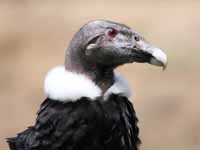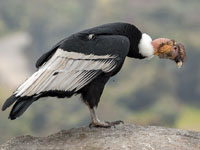THE WORLD BIRDS - An Online Bird Book
RAPTORS
New World Vultures
Order Accipitriformes Family Cathartidae
RAPTORS
Raptors are carnivorous. They hunt by sight during the day, are long lived, and have low reproductive rates. The catch their prey via strong claws – three pointing forward and one pointing backward. The raptors that hunt by day are: hawks, eagle, kites, vultures, falcons. Owls hunt by night. Raptors are also called birds of prey.
Order Accipitriformes, family Accipitridae: hawks, eagles, kites, Old World vultures.
Order Accipitriformes, family Cathartidae: New World vultures
Order Strigiformes, family Strigidae: owls
Order Accipitriformes, family Accipitridae: hawks, eagles, kites, Old World vultures.
Order Accipitriformes, family Cathartidae: New World vultures
Also Accipitriformes: ospreys ( family Pandionidae); secretary bird (family Sagittariidae)
Order Falconiformes, family Falconidae: falconsOrder Strigiformes, family Strigidae: owls
New World Vultures
Order Accipitriformes Family Cathartidae
The Cathartidae family contains the New World vultures. They are not closely related to Old World vultures, but resemble each other because of convergent evolution. Vultures in general feed on dead animals. They tend to have bald heads, the wide-spread belief is that the lack of feathers evolved from the goal of not getting contaminated from carrion. An alternate view is that the bald heads help keep the vultures cooler. But if that is really the reason, then why are not most other species in their regions bald also? Unike the Old World vultures, the Cathartidae vultures lack a syrinx, and can thus only utter hisses and grunts.
The Old World vultures are placed in the family Accipitridae, which also contains the hawks, kites, and eagles. Thus the Old World vultures are closer to the hawks than to the New World vultures! And some people think the two lines of vultures are even more separated - they place the Old World vultures in the order Accipitriformes, and the New World vultures in the different order Cathartiformes. The organizations that use two orders instead of a common order are in the minority.
None of the Old World vultures have a good sense of smell. That is also true for three of the New World vultures: the black vulture, the California condor, and the king vulture. Each of these vultures are in their own genus. The three New World vultures in Cathartes and also the Andean condor all have a good sense of smell which they use to help locate their meals.
The vast majority of the New World vultures can soar almost effortlessly. They are characteristically seen gliding in wide cirles that drift across the country side until they see or smell a carrion , or their neighbor finds one for the meandering funeral procession. Unlike the other 6 New World vultures, the black vulture does not excel at soaring as they have a relative small wing surface area. That said, they are still quite good at soaring which they do while seaching for carrion.
New World vultures live a long time, some species to over 40 years. Because of their long lives they mature sexuallylater than most birds - at around 5 years. Another consequence of their long lives is that they do not lay many eggs at a time: usually one, sometimes two. If their chicks die, then they often "double clutch" - try again the same year. The eggs are usually laid on the ground with some protection over head, such as in a cave. A regular nest is not constructed, but a elementary one may be formed by arranging material that is already on the ground.
Genus Cathartes
The three species in this genus all have a good sense of smell, thus carrrion is located by sight or smell.
Vulture, Greater Yellow-headed Cathartes melambrotus Found: South America
Description: The greater yellow-headed vulture has black plumage. The head and neck, which are featherless, range in color from deep yellow to pale orange. It lacks a syrinx, and its vocalizations are therefore limited to grunts or low hisses. The greater yellow-headed vulture is 65 to 75 cm long. They do not make a nest, but lays eggs on the ground or the hollow of a tree strump. The similar lesser yellow-headed vulture is smaller and lighter in color.
Range: Amazon basin of South America. It is not found in the Andes.
Habitat: Mature forests.
Diet: Carrion - roadkill or other animal carcasses. It prefers relatively fresh meat. Food can be located by sight or smell.
Conservation status: Least Concern.
Image by: 1) Charlie Westerinen 2) Tony_Castro - Ecuador 3, 4) Dave Curtis - GuyanaRange: Amazon basin of South America. It is not found in the Andes.
Habitat: Mature forests.
Diet: Carrion - roadkill or other animal carcasses. It prefers relatively fresh meat. Food can be located by sight or smell.
Conservation status: Least Concern.
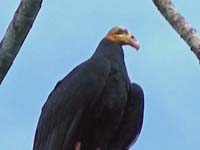
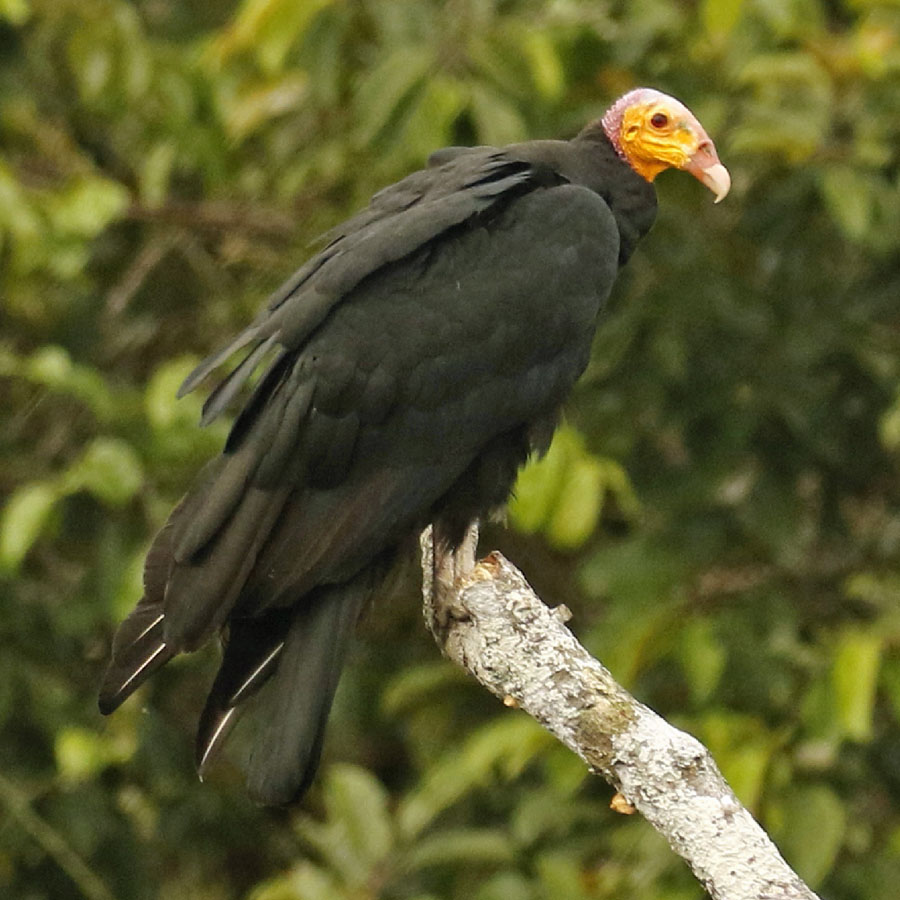
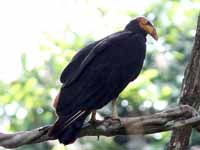
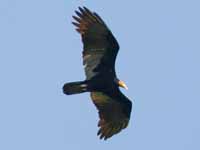
Vulture, Lesser Yellow-headed Cathartes burrovianus
Description: The lesser yellow-headed vulture plumage is black. The head and neck, which are featherless, are pale orange with red or blue areas. It lacks a syrinx, so therefore its vocalizations are limited to grunts or low hisses. It is a solitary bird, not flying with others in a search for food. he lesser yellow-headed vulture is 55 to 65 cm long. It is similar to the greater yellow-headed vulture which is larger and darker. Their nesting habits are similar.
Range: Mexico, Central America, and South America.
Habitat: Lowland grasslands, swamps, degraded forests.
Diet: Carrion - roadkill or other animal carcasses. It prefers relatively fresh meat. Food can be located by sight or smell.
Conservation status: Least Concern.
Image by: 1) Bernard_Dupont - Brazil 2) Jerry Oldenettel - Belize 3) Shane McCann - Belize 4) Cristiano Crolle - ArgentinaRange: Mexico, Central America, and South America.
Habitat: Lowland grasslands, swamps, degraded forests.
Diet: Carrion - roadkill or other animal carcasses. It prefers relatively fresh meat. Food can be located by sight or smell.
Conservation status: Least Concern.
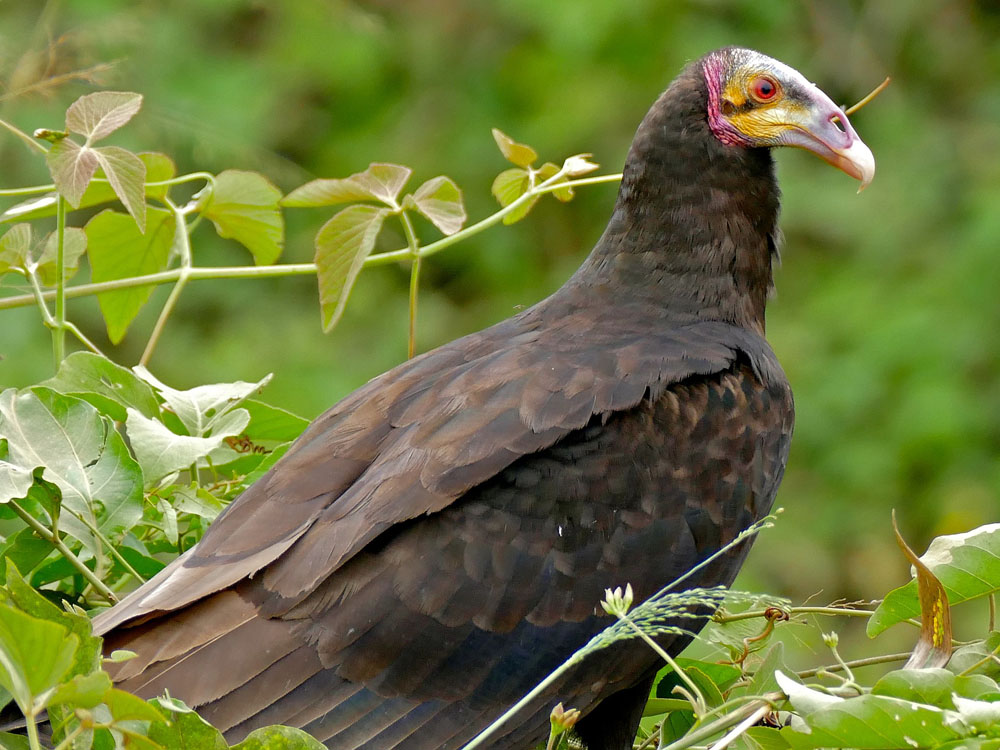
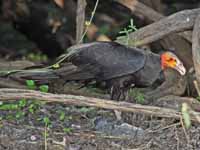
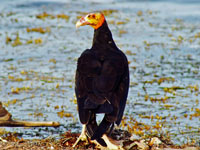
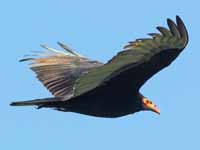
Vulture, Turkey Cathartes aura
Description: The turkey vulture, also known as the turkey buzzard, has mainly brownish-black plumage with whitish flight feathers seen from underneath. It has a small red head. It is the most widespread of the New World vultures. The turkey vulture is 65 to 89 cn long. The similar black vulture has much less white on the underside of its wings and has a "prettier" face. The greater and lesser yellow-headed vultures can be distinguish by their head colore.
Range: Southern Canada to southern South America.
Habitat: Forsts, farm lands, near roads. Not high in mountains.
Diet: Carrion of mammals, birds, reptiles, fish. Food can be located by sight or smell. They seem to soar effortless, often spread out from each other to increase the odds of finding a meal. The sight of a neighbor descending for a find, prompts the others to follow.
Conservation status: Least Concern.
Image by: 1) Dori - Florida 2) Ken Slade - Texas 3) Dick Daniels - North Carolina 4) Dick - Carolina Raptor CenterRange: Southern Canada to southern South America.
Habitat: Forsts, farm lands, near roads. Not high in mountains.
Diet: Carrion of mammals, birds, reptiles, fish. Food can be located by sight or smell. They seem to soar effortless, often spread out from each other to increase the odds of finding a meal. The sight of a neighbor descending for a find, prompts the others to follow.
Conservation status: Least Concern.
4) Leucistic Turkey Vultures (that is, whitish Turkey Vulture)
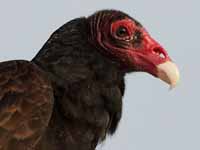
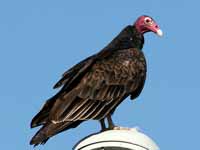
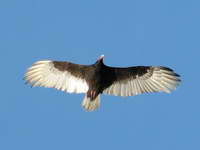
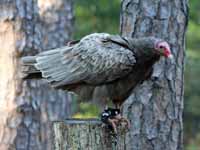
Genus Coragyps - 1 species
Vulture, Black Coragyps atratus
Description: The black vulture, also known as the American black vulture, has mainly black plumage. It has a bare grey head and neck. The underwings are white at the ends (primary flight feathers). It usually does not build a nest, instead placing the eggs on the ground. The black vulture is 60 to 70 cm long. The similar turkey vulture has much more white on the underside of its wings and is also larger than the black vulture. The Black vulture has a "prettier" face.
Range: Southern USA, Central America, South America.
Habitat: Open areas for feeding, dense woodlands for breeding.
Diet: Carrion, eggs, newborn animals. It does not have a good sense of smell and locates carrion by sight. Unlike the other 6 New World vultures, the black vulture does not excel at soaring as they have a relative small wing surface area. That said, they are still quite good at soaring which they do while seaching for carrion.
Conservation status: Least Concern.
Image by: 1) Dick Daniels - Florida 2, 3) Dick - Panama 4) Allan_Hopkins - BrazilRange: Southern USA, Central America, South America.
Habitat: Open areas for feeding, dense woodlands for breeding.
Diet: Carrion, eggs, newborn animals. It does not have a good sense of smell and locates carrion by sight. Unlike the other 6 New World vultures, the black vulture does not excel at soaring as they have a relative small wing surface area. That said, they are still quite good at soaring which they do while seaching for carrion.
Conservation status: Least Concern.
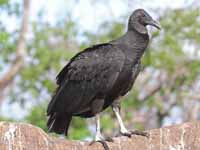



Genus Gymnogyps - 1 species
Condor, California Gymnogyps californianus
Description: The California condor has mainly black with patches of white on the underside of the wings. The head is largely bald, with skin color ranging from grey on young birds to yellow and bright orange on breeding adults. The California condor is 110 to 140 cm long and their weight averages 8 or 9 kg. It has a wingspan of 2.5 to 3 meters which is the largest for any North American bird. Their wings have to work hard for a takeoff on flat ground, but once high in flight they hardly ever flap the wings, but hold them stationary for soaring.
Unusual for raptors, the female is smaller than the male.
The skin color of their head can reflect the condor's emotions. For example, the sexually mature male (6 and older) turns his head red while displaying and trying to attract a female. They mate for life, and their lifespan can reach 60 years. They nest in a cave or on cliffs, hopefully with a tree close by for landings and takeoffs.
The San Diego Zoo has experienced two cases of virgin bird of condors. Both males were proven only to have DNA from the mother. The young birds did not live to sexual maturity so it is unknown if they were fertile. Parthenogenesis has been observed in other bird species, but these are the only known case of the chicks actually hatching and living for a considerable time.
Range: California, Arizona.
Habitat: Rocky shrubland, coniferous forest, and oak savanna.
Diet: Carrion, especially large mammals. The have little or no sense of smell, but find carrion by observing other vultures. They can drive away most competitors except for bear and eagles.
Conservation status: It is listed as Critically Endangered. In the 1980's, when there were less than 25 living California condors, all were captured for a breeding program which was led by the San Diego Zoo and Los Angles Zoo. Condors usually have only one egg per year, but the zoos learned that if the first egg was taken (and of course incubated and hatched) the condor would then lay a second age thus doubling the normal birth rate. Condors are still being bred at zoos, but many have also be reintroduced to the wild. Their total population is now over 500. The major challenge to condor longevity has been the ingestion of lead pellets from animals that were killed by hunting. Lead shot is now illegal in many places.
Image by: 1) Joseph Brandt, USFWS 2) Nathan Rupert - San Diego Zoo 3) Dick Daniels - Grand Canyon 4) Jamie_Chavez - Grand CanyonThe skin color of their head can reflect the condor's emotions. For example, the sexually mature male (6 and older) turns his head red while displaying and trying to attract a female. They mate for life, and their lifespan can reach 60 years. They nest in a cave or on cliffs, hopefully with a tree close by for landings and takeoffs.
The San Diego Zoo has experienced two cases of virgin bird of condors. Both males were proven only to have DNA from the mother. The young birds did not live to sexual maturity so it is unknown if they were fertile. Parthenogenesis has been observed in other bird species, but these are the only known case of the chicks actually hatching and living for a considerable time.
Range: California, Arizona.
Habitat: Rocky shrubland, coniferous forest, and oak savanna.
Diet: Carrion, especially large mammals. The have little or no sense of smell, but find carrion by observing other vultures. They can drive away most competitors except for bear and eagles.
Conservation status: It is listed as Critically Endangered. In the 1980's, when there were less than 25 living California condors, all were captured for a breeding program which was led by the San Diego Zoo and Los Angles Zoo. Condors usually have only one egg per year, but the zoos learned that if the first egg was taken (and of course incubated and hatched) the condor would then lay a second age thus doubling the normal birth rate. Condors are still being bred at zoos, but many have also be reintroduced to the wild. Their total population is now over 500. The major challenge to condor longevity has been the ingestion of lead pellets from animals that were killed by hunting. Lead shot is now illegal in many places.
1) Adult with 30 day chick 2) Juvenile
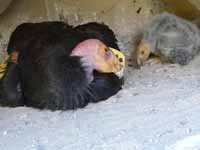
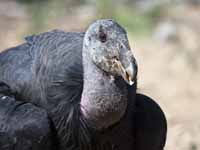
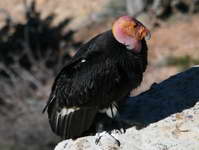

Genus Sarcoramphus - 1 species
Vulture, King Sarcoramphus papa
Description: The king vulture has black and white plumage. It has a black ruff on the neck, black flight feather, lower back, and tail; the rest of the plumage is white. The head and neck are bald, with the skin color varying, including yellow, orange, blue, purple, and red. The king vulture has a very noticeable yellow fleshy caruncle on its bill. It is 67 to 80 cm long, has a wingspan of 1.2 to 2 meters, and weighs between 2.7 and 4.5 kg. This makes the largest New World vulture, except for the condors. "King" could refer to its size or also to the fact the is the dominant vulture at any carrion. It can soar for hours, only occasionally flapping its wings.
Range: Central and South America.
Habitat: Tropical lowland forests.
Diet: Carrion such as fish, lizards, monkey, cattle. Also living wounded animals and small calfs. Though not definitive, the king vulture probably has a poor sene of smell and discovers carrion by watching other vultures species.
Conservation status: Least Concern.
Image by: 1) Eric Kilby - Washington National Zoo 2) B Miry 3) William Wan 4) Renato_MartinsRange: Central and South America.
Habitat: Tropical lowland forests.
Diet: Carrion such as fish, lizards, monkey, cattle. Also living wounded animals and small calfs. Though not definitive, the king vulture probably has a poor sene of smell and discovers carrion by watching other vultures species.
Conservation status: Least Concern.

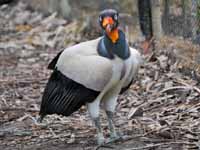

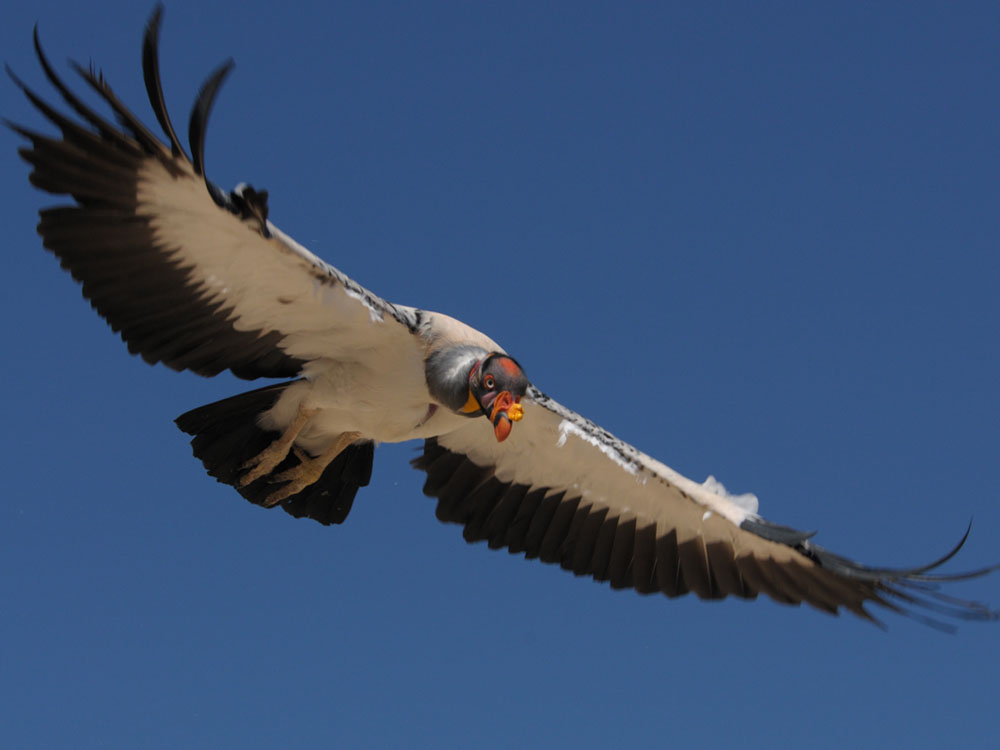
Genus Vultur - 1 species
Condor, Andean Vultur gryphus Found: South America
Description: The Andean condor is a large black vulture with a ruff of white feathers surrounding the base of the neck and, especially in the male, large white patches on the wings. The head and neck are nearly featherless, and are a dull red color, which may flush and therefore change color in response to the bird's emotional state. In the male, there is a wattle on the neck and a large, dark red comb or caruncle on the crown of the head. The Andean condor is 100 to 130 cm long, has a wingspan of up to 3.3 meters, and an averqage weight of 11.3 kg.
Range: The west of South America, near the Andes.
Habitat: In the mountains, near grasslands.
Diet: Carrion, usually of good sized mammels. They discover the carrion by smell or sight.
Conservation status: It is listed as Vulnerable because the population is small mainly due to lead poisoning from ingested pellets.
Image by: 1) Nathan Rupert 2) Dick Daniels - National Aviary 3) Sergey_Pisarevskiy - Columbia 4) Drriss and Marrionn Range: The west of South America, near the Andes.
Habitat: In the mountains, near grasslands.
Diet: Carrion, usually of good sized mammels. They discover the carrion by smell or sight.
Conservation status: It is listed as Vulnerable because the population is small mainly due to lead poisoning from ingested pellets.
